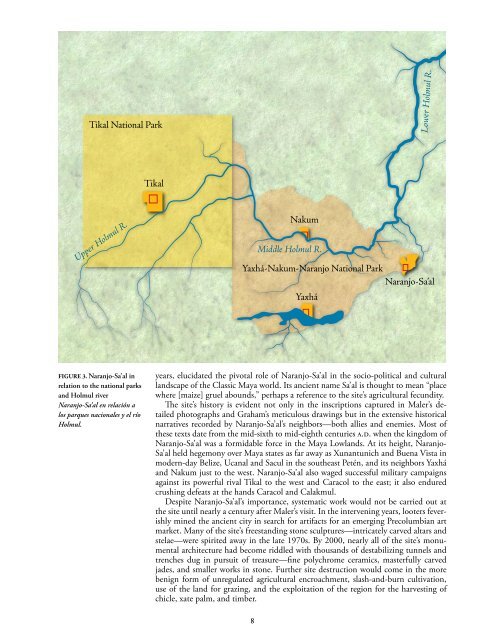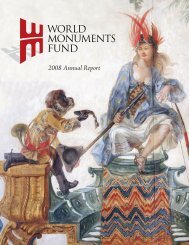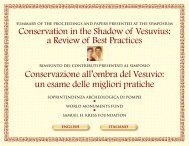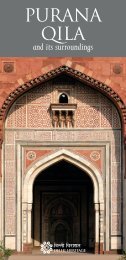NaraNjo-Sa'al - World Monuments Fund
NaraNjo-Sa'al - World Monuments Fund
NaraNjo-Sa'al - World Monuments Fund
Create successful ePaper yourself
Turn your PDF publications into a flip-book with our unique Google optimized e-Paper software.
Tikal National Park<br />
Upper Holmul R.<br />
Figure 3. Naranjo-Sa’al in<br />
relation to the national parks<br />
and Holmul river<br />
Naranjo-Sa’al en relación a<br />
los parques nacionales y el río<br />
Holmul.<br />
Tikal<br />
Yaxhá-Nakum-Naranjo National Park<br />
Naranjo-Sa’al<br />
Yaxhá<br />
years, elucidated the pivotal role of Naranjo-Sa’al in the socio-political and cultural<br />
landscape of the Classic Maya world. Its ancient name Sa’al is thought to mean “place<br />
where [maize] gruel abounds,” perhaps a reference to the site’s agricultural fecundity.<br />
The site’s history is evident not only in the inscriptions captured in Maler’s detailed<br />
photographs and Graham’s meticulous drawings but in the extensive historical<br />
narratives recorded by Naranjo-Sa’al’s neighbors—both allies and enemies. Most of<br />
these texts date from the mid-sixth to mid-eighth centuries a.d. when the kingdom of<br />
Naranjo-Sa’al was a formidable force in the Maya Lowlands. At its height, Naranjo-<br />
Sa’al held hegemony over Maya states as far away as Xunantunich and Buena Vista in<br />
modern-day Belize, Ucanal and Sacul in the southeast Petén, and its neighbors Yaxhá<br />
and Nakum just to the west. Naranjo-Sa’al also waged successful military campaigns<br />
against its powerful rival Tikal to the west and Caracol to the east; it also endured<br />
crushing defeats at the hands Caracol and Calakmul.<br />
Despite Naranjo-Sa’al’s importance, systematic work would not be carried out at<br />
the site until nearly a century after Maler’s visit. In the intervening years, looters feverishly<br />
mined the ancient city in search for artifacts for an emerging Precolumbian art<br />
market. Many of the site’s freestanding stone sculptures—intricately carved altars and<br />
stelae—were spirited away in the late 1970s. By 2000, nearly all of the site’s monumental<br />
architecture had become riddled with thousands of destabilizing tunnels and<br />
trenches dug in pursuit of treasure—fine polychrome ceramics, masterfully carved<br />
jades, and smaller works in stone. Further site destruction would come in the more<br />
benign form of unregulated agricultural encroachment, slash-and-burn cultivation,<br />
use of the land for grazing, and the exploitation of the region for the harvesting of<br />
chicle, xate palm, and timber.<br />
8<br />
Nakum<br />
Middle Holmul R.<br />
Lower Holmul R.
















